Los Angeles, California Travel Guide
About Know the Neighborhoods Getting Around Attractions Hotels
Eats & Nightlife Essentials & Practicals
Chinatown
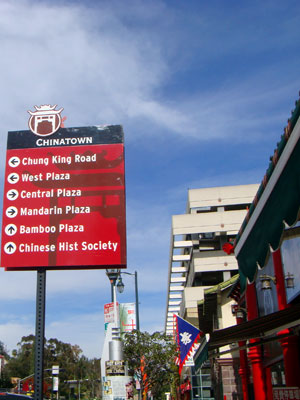
Chinatown sign downtown LA
Area: Downtown Los Angeles
Overview: One of Los Angeles’ more interesting areas and places to visit, Chinatown has a long, fascinating story. Today’s Chinatown in Los Angeles sits south of the 110 Freeway (below Echo Park and Silverlake) and is bordered on the south side by Cesar E Chavez Ave and Alameda St to the east. The main north and south streets are Hill, Spring and Broadway.
One of the largest Chinatowns in the United States (San Francisco has the largest Chinatown community), Chinatown as we know it today in Los Angeles dates back to 1938. As of this writing in 2009, Chinatown is celebrating the powerful Year of the Ox in the Chinese Zodiac. But, today’s popular Chinatown wasn’t always flourishing. Chinatown L.A. has its humble and turbulent beginnings with the Chinese first settlement in the 1850s. A small but growing settlement emerged southeast of the current New Chinatown around Alameda St and today’s Union Station. Political and economic pressures, corruption and a decreasing Chinese population in the old Chinatown location eventually led to the new Chinatown, where it stands today. The official mark of the New Chinatown L.A. occurred with the dedication of the Central Plaza in 1938 by Governor Frank Merriam.
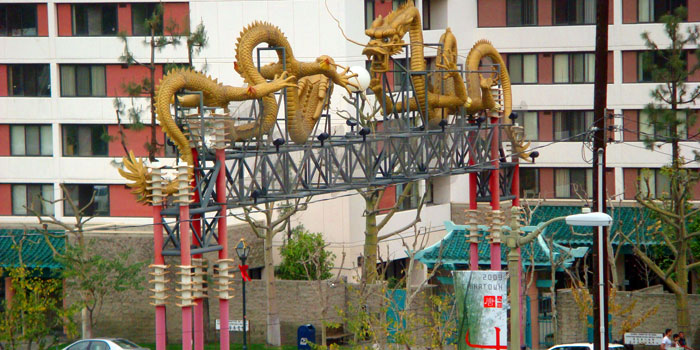
Chinatown Gate in LA
I love L.A.’s Chinatown. It has many of the authentic features of Chinese cities of mainland China and Hong Kong: some strong smells, the people, the architecture of pagodas entrances and sloping roofs, the souvenirs and the cuisine. Chinatown does have a distinctly American L.A. flava so don’t rush in thinking you’ll find sidewalk vendors with makeshift grills and pots selling fried dough.
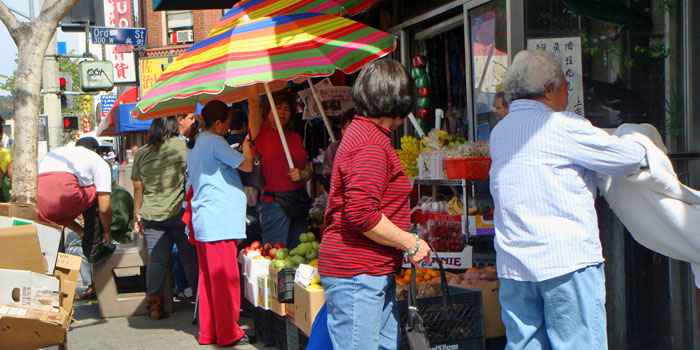
Markets in Chinatown Downtown LA
Start your visit of Chinatown at Cesar Chavez Ave and Broadway. There, you’ll see the Chinatown Gate. As luck and business planning would have it, there’s a gigantic parking lot on the northwest corner where you can park your car for $5.00 a day. Chinatown is most definitely a place in which you want to walk or wheel. Quickly, you’ll encounter colorful open air, sidewalk markets and stalls, selling souvenirs and knickknacks. The sidewalks can get a little congested with all the vendors and their wares and the crowds. If the vendors don’t do it for you, the distinctive buildings and the local fish market will assault your senses. Hit up the local bakeries such as the Queen’s Bakery or Phoenix Bakery, the largest bakery in Chinatown.
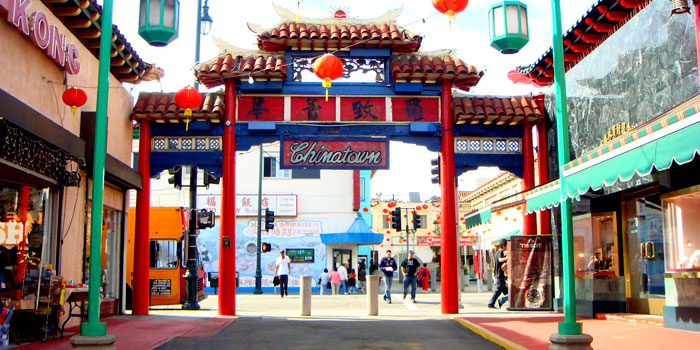
Central Plaza in Chinatown Downtown LA
Make your way up north on Broadway just north of College St and you’ll end up at the historic and most famous part of Chinatown, Central Plaza, the dedication site of the today’s Chinatown by Governor Merriam. Stroll around, shop or dine at any of the colorful cafes or stop by the slick and trendy Grand Star Jazz Club at night. Step to the west entrance/exit onto Hill St and go up a few yards. Across Hill St, you’ll see what only locals know, Chung King Court and road, an art and bohemian, pedestrian only area in Chinatown L.A. Further north a little ways is Bamboo Plaza. Inside this multi-tiered plaza of shops is the most famous restaurant in Chinatown, Empress Pavilion, known for the tastiest dim sum around the globe (Chinatown globe that is). After some dim sum, head north about 20 yards and you’ll find the Grand Stone Union, Inc. shop with an impressive array of stone statues of dragons and other Chinese motifs.
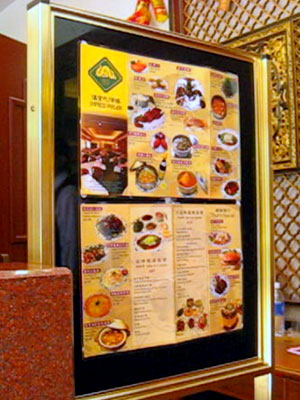
Empress Pavilion in Chinatown with the best dim sum
A great thing about Chinatown is that prices are a little more affordable than the rest of Los Angeles. The price for a bottle of water from one of the local grocery stores is $0.75. Steamed or baked sho pao at Family Pastry off Spring St and Ord St are $0.65. The savings in Chinatown don’t stop at the local grocery stores and pastry shops.
South of College St on the east side of Broadway, vendors in Chinatown Plaza and Saigon Plaza offer great deals in these outdoor bazaars. Head back south on Broadway on the east side. In the midst of mom and pop stores, you’ll come across a nondescript, large metal door to what appears to be a garage. And, The Garage is just what the sign reads above the door. If you stroll by earlier in the afternoon, a little doorway is open where you can enter. In the late afternoon, the entire metal door rolls up to a vast warehouse full of factory sale clothing. At the entrance, two tables are set up on either side with girls dancing on top. Way to draw the male customers. But, great deals can be had here.
Accessibility: The streets and sidewalks are wheelchair accessible in Chinatown Los Angeles. Curbs have ramps and most businesses don’t have steps or they have elevators. Chinatown is built on a slight incline. From the south at Cesar Chavez, you’ll climb up slightly along Broadway or Hill streets. But, there is a steeper climb from Spring to Alameda.
Getting There: The Metro Gold Line runs through Chinatown. The metro stop is at 901 N. Spring St, Los Angeles, CA 90012. Union Station is also just a block away from Chinatown. The LADOT Dash Bus has has a route through Chinatown. www.ladottransit.com.